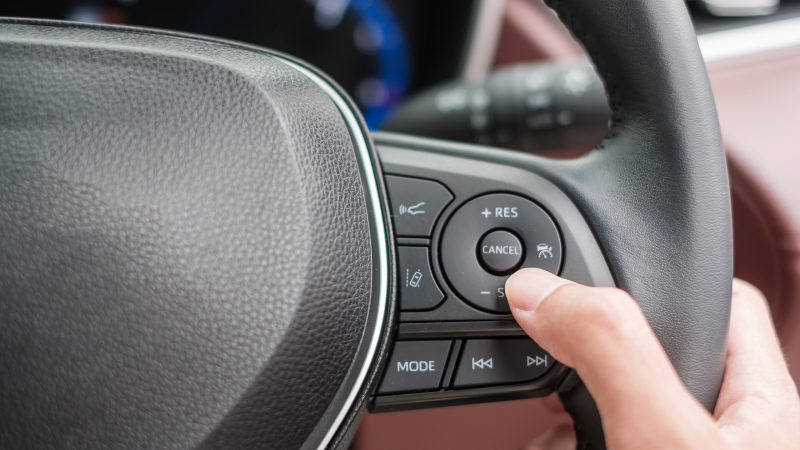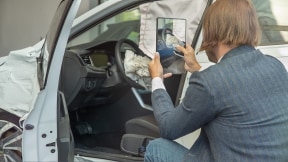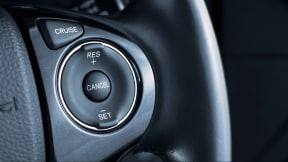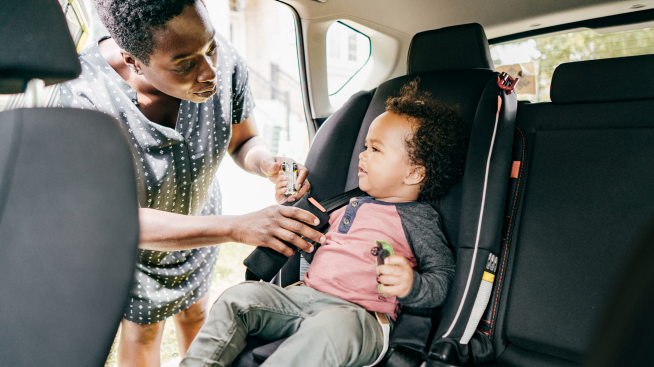How does cruise control work?

Quick insights
- Cruise control is a feature designed to help cars maintain a consistent speed.
- Standard cruise control needs to be set manually, while adaptive cruise control uses lasers and radar to choose a set speed.
- It may be safer to avoid using cruise control in wet or icy conditions to avoid hydroplaning.
Cruise control is more than just a catchy name—it's a feature that you may just find in your own vehicle. Wondering how cruise control works after spotting it on your steering wheel? Read on to learn more.
What is cruise control?
Cruise control is an automated vehicle system that can manage your car’s acceleration to keep it traveling at a steady speed. This can be useful for drivers who are covering long distances on relatively straight roads, as it spares them the fatigue of keeping their foot on the gas for extended stretches of time. Other possible benefits include:
- Increased fuel efficiency from keeping a constant speed.
- Less distraction from speed adjustments, so the driver can pay more attention to the road.
Cruise control systems typically work by adjusting your car’s throttle, which moderates the air going to the engine. In older cars, this was done with a system of physical cables connected to the throttle valve, but newer cars have electronic systems that can adjust the car’s speed with an even higher degree of precision. A system of sensors constantly relays information about the car’s speed back to the cruise control system, which adjusts the throttle accordingly to maintain the desired speed.
The specifics of using a car’s cruise control vary quite a bit from car to car. It’s best practice to consult the owner’s manual for your car for precise information, but some basics are included below:
- Most cruise control systems typically have a button labeled “Set.” When you press this button, the system will engage cruise control at whatever speed you’re currently travelling. Some systems may also have an option to set a higher speed by pressing or holding the button down.
- Stepping on the brakes at any point will disengage the cruise control, while pressing the “Resume” button will return the car to the set speed.
- There is typically also an “Off” button, which will automatically shut off the cruise control when pressed.
- Most cruise control systems typically won’t activate below a certain speed limit. The exact limit may vary by car but is often somewhere in the range of 30-40 miles per hour.
Adaptive cruise control vs. standard cruise control
By now, you may have picked up on a potential drawback of cruise control—keeping a steady speed is harder to do (and possibly dangerous) when there are other drivers in front of you. This is why car makers invented adaptive cruise control.
With adaptive cruise control, your car uses radar and laser sensors to detect the speed of vehicles ahead and then adjusts your own speed accordingly to keep a safe distance. So, if the car in front of you slows down, your car will too. Once they’re out of the way, your adaptive cruise control will accelerate back to the speed you previously set.
Standard cruise control, on the other hand, requires you to manually turn off the cruise control (or automatically disengage it by pressing on the brakes) when you notice traffic up ahead.
When to use cruise control
Cruise control was originally designed to be used on long drives and road trips when it’s possible to maintain a constant speed. Highway driving is still the typical time to deploy your cruise control, but the development of adaptive cruise control has made it possible to potentially use your cruise control for certain city driving scenarios as well.
When not to use cruise control
It’s also important to know when not to use cruise control. It's generally best to avoid using this feature when:
- There’s a lot of traffic on the road, and it would be difficult to hold one steady speed for long.
- The roads are wet or icy, as it may limit your ability to decelerate or stop quickly enough if you start hydroplaning.
- You’re fatigued, as the ability to relax your legs may increase the risk of potentially falling asleep behind the wheel.
In summary
Cruise control is more than simply a modern convenience. In the right circumstances, it can potentially enhance your driving experience by reducing fatigue, increasing safety and improving fuel efficiency. Haven’t tried using cruise control before? Perhaps it’s time to take the leap and try it out for yourself the next time you’re shopping for a new car.



